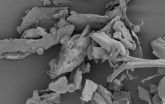(Press-News.org) (PHILADELPHIA) -- Alternative medicines are widely thought to be at least harmless and very often helpful for a wide range of discomforts and illnesses. However, although they're marketed as "natural," they often contain active ingredients that can react chemically and biologically with other therapies. Researchers performed a comprehensive review of all of the medications taken by senior oncology patients and found that as 26 percent were using complementary or alternative medicines (CAM), in a report published August 12th, in the Journal of Geriatric Oncology.
"Currently, few oncologists are aware of the alternative medicines their patients take," says Ginah Nightingale, PharmD, an Assistant Professor in the Jefferson College of Pharmacy at Thomas Jefferson University. "Patients often fail to disclose the CAMs they take because they think they are safe, natural, nontoxic and not relevant to their cancer care, because they think their doctor will disapprove, or because the doctor doesn't specifically ask."
There are a number of CAMs that are known to interfere with certain cancer treatments. For example, St. John's wart can make some cancer therapy less effective, according to the National Institutes of Health. Others can interfere with anesthesia during surgery for cancer. But not all interactions have been studied. Because CAMs fall under the category of health supplements, they are not regulated by the Food and Drug Administration (FDA), which means that dose and potency (and therefore reaction in the body) can vary widely between products, and between patients.
In addition, in an elderly population of cancer patients, CAMs can simply add additional medications to an already long list of drugs taken for various ailments. "Numerous pills, or what we call polypharmacy in the field, can increase the risk for medication non-adherence, potential drug-drug interactions and increase the risk for drug-disease interactions in a population that has been reported to take several medications and have several medical conditions," says Dr. Nightingale, "The use of CAM in this subpopulation warrants substantial interest and concern on behalf of medical oncologists and allied health professionals because of the potential clinical implications associated with CAM use. Patients may be combining these agents while receiving concurrent systemic chemotherapy, radiation therapy and/or surgical interventions which have the potential to compromise the safety and efficacy of treatment interventions."
Dr. Nightingale and colleagues surveyed the senior oncology patients who came to Jefferson for consultations in the Senior Adult Oncology Multi-Disciplinary clinic. Over the course of one visit, patients were seen by professionals from five different areas crucial to maintaining a senior's health throughout oncology treatment, including a medical oncologist, geriatrician, clinical pharmacist, social worker and dietician. As part of this assessment, the patients brought in the contents of their medicine cabinets, and the medications that were actively used were reviewed and recorded.
The research team found that 26 percent of patients were taking CAMs at some point during the continuum of their cancer care, with the highest usage among women over the age of 80 - a population that hadn't been captured by previous studies. Among those taking complementary medicine, 68 percent were in the over-80-year-old range.
Some of the alternative medications that were commonly used in this population were alternative therapies for macular degeneration, stomach probiotics, joint health, and mega-dose vitamins or minerals. While the current study did not examine the potential adverse events caused by these medications, "we know that some can have a biochemical effect on the body and other drugs." says Nightingale.
"It is very important to do a comprehensive screen of all of the medications that older cancer patients take, including CAMs," says Dr. Nightingale. "Clear and transparent documentation of CAM use should be recorded in the patient's medical record. This documentation should indicate that patient-specific communication and/or education was provided so that shared and informed decisions by the patient can be made regarding the continued use of these medications."
"Oncology healthcare is undergoing significant transformation in the delivery of effective clinical services and is ripe for greater engagement of pharmacists to reduce drug-related problems and unnecessary medications, in order to optimize medication prescribing," says Dr. Nightingale.
INFORMATION:
For more information, contact Edyta Zielinska, 215-955-5291, edyta.zielinska@jefferson.edu.
About Jefferson -- Health is all we do.
Our newly formed organization, Jefferson, encompasses Jefferson Health and Thomas Jefferson University, representing our clinical and academic entities. Together, the people of Jefferson, 19,000 strong, provide the highest-quality, compassionate clinical care for patients, educate the health professionals of tomorrow, and discover new treatments and therapies that will define the future of health care.
Jefferson Health comprises five hospitals, 13 outpatient and urgent care centers, as well as physician practices and everywhere we deliver care throughout the city and suburbs across Philadelphia, Montgomery and Bucks Counties in Pa., and Camden County in New Jersey. Together, these facilities serve more than 78,000 inpatients, 238,000 emergency patients and 1.7 million outpatient visits annually. Thomas Jefferson University Hospital is the largest freestanding academic medical center in Philadelphia. Abington Hospital is the largest community teaching hospital in Montgomery or Bucks counties. Other hospitals include Jefferson Hospital for Neuroscience in Center City Philadelphia; Methodist Hospital in South Philadelphia; and Abington-Lansdale Hospital in Hatfield Township.
Thomas Jefferson University enrolls more than 3,900 future physicians, scientists, nurses and healthcare professionals in the Sidney Kimmel Medical College (SKMC); Jefferson Colleges of Biomedical Sciences, Health Professions, Nursing, Pharmacy, Population Health and is home of the National Cancer Institute (NCI)-designated Sidney Kimmel Cancer Center
For more information and a complete listing of Jefferson services and locations, visit http://www.jefferson.edu.
(Boston)--Educating clinicians on how to safely prescribe opioids can help decrease opioid misuse among chronic pain sufferers.
These findings, which appear online in the journal Pain Medicine, confirm that education can empower clinicians to make more informed clinical decisions about initiating, continuing, changing or discontinuing opioids for patients suffering from chronic pain based on a careful benefit versus risk/harm assessment.
Chronic pain affects approximately 100 million people in the U.S. making it one of the most common reasons patients seek medical ...
The great escape: why awareness of our own mortality can be bad for our health
People with low self-esteem use a variety of escape mechanisms to avoid thinking about their own mortality, new research reveals.
Researchers led by Dr Arnaud Wisman, of the University of Kent's School of Psychology, found evidence in five studies that people with low self-esteem respond to reminders of their own mortality by directing their focus away from the 'self'.
The research found an empirical and causal link between people with low self-esteem having unconscious concerns about ...
This news release is available in German. An LMU team has shown that the axons of auditory neurons in the brainstem which respond to low and high-frequency sounds differ in their morphology, and that these variations correlate with differences in the speed of signal conduction.
As a rule, the axons (i.e. signal-transmitting fibers) of the neurons in the central nervous systems of vertebrates are ensheathed in layers of myelin, which serves as a form of insulation that improves their electrical conduction properties. In fact, the fat-rich myelin coating largely consists ...
Rehabilitation is recommended for many patients following a hospital stay for acute heart disease. In a recent original article in Deutsches Ärzteblatt International (Dtsch Arztebl int 112: 527-34) Axel Schlitt et al. show that this improves prognosis for heart disease and can thus reduce patient mortality.
More than 1900 patients in Saxony-Anhalt were contacted and asked to fill out a questionnaire. They had spent time in the hospital for serious cardiovascular disease an average of 11 years earlier. The authors used the data to analyze how many of the patients who ...
Cholecystectomy and treatment for inguinal, femoral, umbilical, or abdominal hernia are common surgeries and are considered routine in Germany. In an original article in the current edition of Deutsches Ärzteblatt International (Dtsch Arztebl Int 112: 535-43), Ulrike Nimptsch and Thomas Mansky show that fewer than 0.5% of patients die as a result of such surgeries. However, in those who do die risks are frequently apparent even before surgery.
Between 2009 and 2013, 731 000 cholecystectomies and 1 023 000 herniotomies took place in Germany. Over 2400 of the patients ...
This news release is available in Spanish. The behaviour involving rejection of new foodstuffs is a typical phase in infant development, above all in 2- to 3-year-olds and which subsides around the age of 5. The children who go through dietary neophobia also display signs of anguish and anxiety and this behaviour may even turn into a habit in adulthood.
In her PhD thesis the researcher of the UPV/EHU's Faculty of Psychology Edurne Maiz conducted a study on 831 schoolchildren between the ages of 8 and 16. In the study she used questionnaires on infant neophobia -adapted ...
University of Alberta paleontologists have discovered a new species of lizard, named Gueragama sulamericana, in the municipality of Cruzeiro do Oeste in Southern Brazil in the rock outcrops of a Late Cretaceous desert, dated approximately 80 million years ago.
"The roughly 1700 species of iguanas are almost without exception restricted to the New World, primarily the Southern United States down to the tip of South America," says Michael Caldwell, biological sciences professor from the University of Alberta and one of the study's authors. Oddly however, iguanas closest ...
The humble dust collecting in the average American household harbors a teeming menagerie of bacteria and fungi, and as researchers from the University of Colorado Boulder and North Carolina State University have discovered, it may be able to predict not only the geographic region of a given home, but the gender ratio of the occupants and the presence of a pet as well.
The new findings, which were published today in the journal Proceedings of the Royal Society B, highlight the impressive amount of microbial diversity in the average household and the degree to which these ...
Dutch research shows that trained detectives of specialized observation teams are much better at registering details of a drug deal than ordinary civilians. Previous legal-psychological research revealed no relevant differences in observation skills between police professionals and civilians. The findings have been published in Legal and Criminological Psychology.
Judges and juries often assume that police officers' statements are more reliable than those of regular eyewitnesses. Because of this assumption, police officers' statements typically carry more weight in legal ...
Only one in five gay and bisexual teen boys have been tested for HIV
HIV infections are on the rise for young men who have sex with men
Text messages, online program can identify nearby confidential testing sites
Testing in schools would 'normalize' the process.
CHICAGO --- Young men who have sex with men have the highest risk for HIV infection, but only one in five has ever been tested for HIV, a much lower rate than testing for non-adolescents, reports a new national Northwestern Medicine study conducted in partnership with the Center for Innovative Public ...

